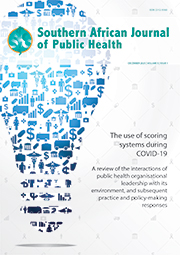Articles

Frequency and distribution of drug-resistant tuberculosis gene mutations in Africa between 2010 and 2020
Abstract
Background. Tuberculosis (TB) has been a cause of millions of deaths worldwide for many years. According to the World Health Organization Global Tuberculosis Report from 2017 to 2019, Africa was one of the regions most affected by TB. There have been many studies of gene mutations accounting for drug resistance; however, research studying the distribution and the frequency of these mutations is still limited.
Objective. To describe the frequency and distribution of TB gene mutations throughout the African continent during the period 2010 - 2020, and to forecast the spread of drug-resistant TB in Africa.
Methods. Information from 113 articles on the PubMed database published in English from 2010 to 2020 was reviewed to identify gene mutations. The countries in which the mutations were reported were also recorded, to study the distribution. Finally, statistical data and graphs were established to track the mutations.
Results. There were 22 gene mutations reported from 25 countries throughout Africa. Among them, mutations of the genes rpoB (f=20.48%), katG (f =15.66%), gyrA (f =13.25%) and inhA (f = 7.23%) were most commonly reported from countries in all regions of Africa: rpoB (n=17), katG (n=13), gyrA (n=11) and inhA (n=16). Southern Africa had the greatest variety of TB mutated genes, while East Africa had the highest number of countries reporting mutations.
Conclusion. Many TB gene mutations were recorded throughout the African continent. Some countries reported unique mutated genes. This reflects the diversity of drug resistance. Many countries also reported the same mutated genes, which will help to forecast the spread of drug-resistant TB during the coming years. Gene mutation was related to multidrug-resistant TB. Further study is necessary to provide an accurate evaluation of multidrug-resistant TB in Africa.
Authors' affiliations
BH Nam, Department of General Medicine, School of Medicine, International University of Health and Welfare, Narita-shi, Japan
K Nishizato, Department of General Medicine, School of Medicine, International University of Health and Welfare, Narita-shi, Japan
K Sugimoto, Department of General Medicine, School of Medicine, International University of Health and Welfare, Narita-shi, Japan
M Ueki, Department of General Medicine, School of Medicine, International University of Health and Welfare, Narita-shi, Japan
R Karibe, Department of General Medicine, School of Medicine, International University of Health and Welfare, Narita-shi, Japan
T Yashio, Department of General Medicine, School of Medicine, International University of Health and Welfare, Narita-shi, Japan
Y Nishi, Department of General Medicine, School of Medicine, International University of Health and Welfare, Narita-shi, Japan
T Munkhtuya, Department of Public Health, School of Medicine, International University of Health and Welfare, Narita-shi, Japan
Full Text
Cite this article
Article History
Date published: 2022-04-12
Article Views
Full text views: 825

.jpg)


Comments on this article
*Read our policy for posting comments here